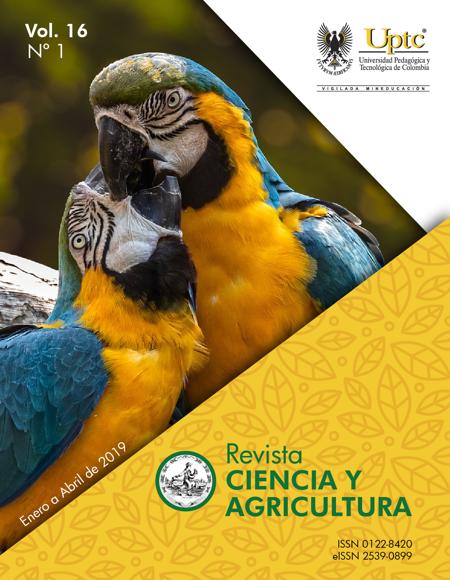Calibration of rising plate meter in prairie kikuyo grass (Pennisetum Clandestinum Hochst.Ex Chiov) in the high colombian tropics

Abstract
The Colombian Andean region, in the department of Boyacá at 2,560 meters above sea level in the Colombian dairy belt, livestock farms are characterized by the predominant perennial forage species known as Kikuyo (Pennisetum clandestinum Hochst.ex Chiov), a stoloniferous growth grass. The objective of this study was to obtain the linear regression equation for the proper calibration of the forage dish in order to predict the availability of dry matter per hectare. This investigation was carried out in the course of 2014, (from March to December); for this investigation, measurements were taken with a Forage Plate in 21 cattle farms belonging to the Alto Chicamocha region. A total of four hundred (400) samples were taken during the dry and rainy seasons. The formula was developed by means of a mathematical method of simple linear regression, relating the compressed height of the forage and the actual availability of dry matter obtained by cutting and subsequent drying. %. According to the formula it was determined that for each unit of measurement of the forage dish, the total phytomass availability was increased in 259.42 kg of Dry Matter (MS) and an intercept of 2978.92 was obtained. These results lead to the use of the equation as an alternative to calculate dry matter available throughout the year in Kikuyo grasslands. The resulting equation for the calibration of the Forage Plate in Kikuyo grasslands (Pennisetum clandestinum) was Kg Ms / Ha = 259.42x + 2978.9 where the height compressed by the forage dish was replaced and with a coefficient of determination (R2) of 77.67%.
Keywords
calibration, compressed height, dry matter, kikuyu, linear regression
References
Araya-Mora, M., & Boschini-Figueroa, C. (2005). Producción de forraje y calidad nutricional de variedades de Pennisetum purpureum en la Meseta Central de Costa Rica. Agronomía Mesoamericana, 16(1), 37-43. DOI: https://doi.org/10.15517/am.v16i1.5180.
Balocchi, O., Pulido, R., & Merino, V. (2013). Oferta diaria de pradera: Efecto sobre el rendimiento y calidad de la pradera y sobre la producción de leche por vaca y por hectárea. Agro Sur, 41, 9-16.
Macías Ferreira, R., & Clavijo Villamizar, E. (2015). Efecto de dos disponibilidades de pradera sobre la tasa de sustitución al ofrecer alimentos balanceados en vacas lecheras. Tesis de pregrado, Universidad de la Salle, Bogotá D.C., Colombia.
Fonseca, C., Balocchi, O., Keim, J. P., & Rodríguez, C. (2016). Efecto de la frecuencia de defoliación en el rendimiento y composición. Agro Sur, 44(3), 67-76.
Fulkerson, W. J., & Slack, K. (1993). Estimating mass of temperate and tropical pastures in the subtropics. Australian Journal of Experimental Agriculture, 33(7), 865–869. DOI: https://doi.org/10.1071/EA9930865.
García, F. A. L., Miranda, J. A., & Borge, W. A. C. (2017). Producción y calidad de forraje con enmiendas orgánicas en pastura (Brachiaria Brizantha), en la Costa Caribe Sur de Nicaragua. Revista Universitaria del Caribe, 18(1), 83–90. DOI: https://doi.org/10.5377/ruc.v18i1.4810.
Li, G. D., Helyar, K. R., Castleman, L. J., Norton, G., & Fisher, R. P. (1998). The implementation and limitations of using a falling plate meter to estimate pasture yield. En Proceedings of the 9th Australian Agronomy Conference, pp. 322-325.
Lile, J. A., Blackwell, M. B., Thomson, N. A., Penno, J. W., Macdonald, K. A., Nicholas, P. K., … Coulter, M. (2001). Practical use of the rising plate meter (RPM) on New Zealand dairy farms. En Proceedings of the Conference-New Zealand Grassland association, pp. 159-164.
Linares Peñuela, C. M., & Cárdenas Jeréz, J. A. (2015). Calibración del rising plate meter para estimular la disponibilidad de materia seca en praderas mixtas lolium perenne-pennisetum clandestinum, en el municipio de Cota, Cundinamarca. Tesis de pregrado, Universidad de la Salle, Bogotá D.C., Colombia.
López Caiza, V. C. (2018). Eficiencia de la fertilización nitrogenada sobre el crecimiento y la calidad del forraje en pastos perennes. Tesis de pregrado, Universidad Católica del Ecuador, Quito, Ecuador.
Michell, P. (1982). Value of a rising-plate meter for estimating herbage mass of grazed perennial ryegrass-white clover swards. Grass and Forage Science, 37(1), 81-87. DOI: https://doi.org/10.1111/j.1365-2494.1982.tb01580.x.
Parga, J. (2003). Utilización de praderas y manejo de pastoreo. Seminario hagamos de la lechería un mejor negocio. Instituto de investigaciones Agropecuarias, Centro de Investigación Remehue. Osorno, Chile.
Pérez Argoti, M. D. (2017). Comparación del método del plato medidor de la altura comprimida y el método del cuadrante para la determinación del rendimiento de materia seca en praderas sobre los tres mil metros de altitud. Tesis de pregrado, Universidad Católica del Ecuador, Quito, Ecuador.
Rayburn, E. B. (1997). An acrylic plastic weight plate for estimating forage yield. West Virginia University Extension Service.
Vergara, J. J. S. (2016). Las praderas, sus asociaciones y características: una revisión. Acta Agrícola y Pecuaria, 2(1), 1-11.
White, J., & Hodgson, J. G. (1999). New Zealand pasture and crop science. Oxford University Press.
